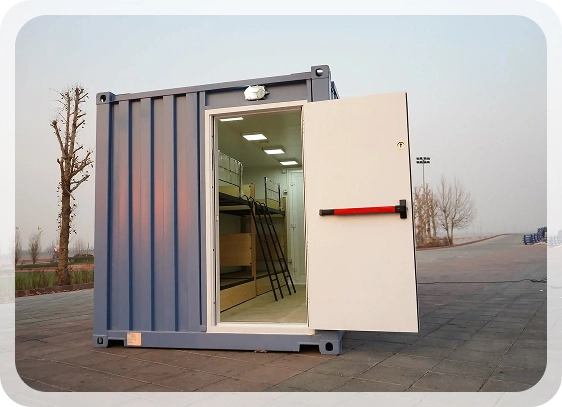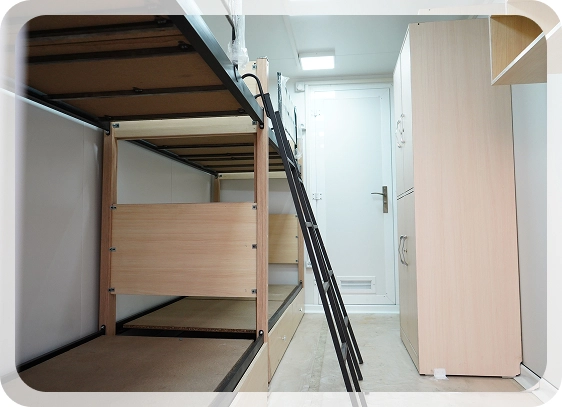Fire-Resistant Cabins by Mammut Structures
Mammut Structures’ fire-resistant cabins are designed and manufactured fully in accordance with NFPA standards.
A fire-resistant cabin is defined as a structure capable of withstanding temperatures up to 1100°C for one hour, based on the global NFPA standard. Mammut Structures’ fire-resistant cabins are fully designed and manufactured in accordance with NFPA standards and find extensive applications in the oil and gas industries.
Among the advantages of these cabins, compared to other manufacturers, are the use of premium raw materials with various certifications, advanced technical expertise, and stringent quality control throughout all production stages.
One of the outstanding features of these cabins is the use of fire-resistant paint with a thickness of up to 1500 microns, which is significantly more durable than electrostatic paints and is beyond the manufacturing capability of many producers.
If you would like to receive a free professional consultation, please fill in your information in the form below. Our experts will contact you as soon as possible to provide the specialized services you need.
Fire-resistant containers are constructed based on precise engineering principles and advanced materials. Understanding the technical specifications of an explosion-proof container helps in making a better decision when purchasing a Mammut container. The table below provides a summary of the key features of a fire-resistant container:
|
Feature
|
Technical Description
|
|---|---|
|
Manufacturing Standard
|
NFPA (Global Standard for Fire Resistance)
|
|
Heat Resistance
|
Up to 1100°C for 1 hour
|
|
Internal Insulation
|
Rockwool with a density of 120 kg/m³ (Thermal conductivity coefficient: 0.041 W/m.K)
|
|
Coating Paint
|
Fire-resistant paint with a thickness of up to 1500 microns
|
|
Indirect Explosion Resistance
|
Up to 2 kPa
|
|
Internal Structure
|
40×40 mm profile + two-stage reinforcement
|
|
Door Sealing
|
Sealing strip and airtight rubber seal
|
|
Customization Possibility
|
Yes (dimensions, internal lining, frame design, etc.)
|
|
Suitable for Use In
|
Oil, gas, petrochemical, military, and laboratory industries, control rooms, and civil defense
|
|
Special Cladding
|
Option for internal or external cladding with stainless steel for laboratory applications
|
The technical specifications above demonstrate the unique capabilities of the fire-resistant container to handle critical and sensitive conditions, making it an intelligent choice for industrial and security projects.
In selecting a fireproof container, the type of structure plays an important role in its functionality and portability. Depending on the usage needs, fireproof containers are generally divided into two main categories:
Fixed fireproof containers are designed for permanent installation in locations with special conditions. These types of structures are often installed in areas where a permanent isolated, control, or crisis management center is required.
Key Features:
Common applications for fixed fireproof containers include the oil and gas industry, substations, hospital centers, and isolated rooms.


Mobile Fireproof Containers are suitable for projects that require frequent relocation or temporary installation in various locations. Their structure is designed to maintain high thermal resistance while also remaining stable under the stresses of transportation.
Key Features:
Lighter design and durable chassis for easy transport
Equipped with transferable safety equipment
Suitable for field projects, industrial sites, or support workshops
Mobile fireproof containers are particularly useful for projects located in hazardous or remote areas.
Benefits of Consulting with Mammut Structures








Before purchasing an explosion-proof container, paying attention to a few points can prevent additional costs or performance issues in the future:
Making an informed decision when purchasing an explosion-proof container will guarantee the safety, efficiency, and durability of your project. It is recommended to consult with a technical advisor to review environmental conditions, safety standards, and the required level of customization before making your final selection, ensuring the product suits your actual needs.
The price of a fireproof container depends on various factors, each of which directly affects the final cost. The first factor is the size and custom design; the larger the container and the more complex the design, the higher the construction cost. The type of materials used is also very important. Using thicker galvanized sheets, high-thickness fire-resistant paints, or higher-density insulation increases the final price. In some models, to improve safety and insulation, heat-resistant wall sandwich panels are used.
Another important factor is the type of use and installation location. For example, if the container is designed for a laboratory or sensitive industrial environment and requires scratch-resistant stainless steel coverings or special equipment, it naturally comes at a higher price. Additionally, transportation costs, installation, interior equipment, and after-sales services also impact the final price calculation.


Choosing a specialized and experienced manufacturer in the field of resilient structures not only guarantees the final quality of the project but also optimizes costs. When purchasing a fireproof container, be sure to consider the manufacturer’s production history, technical capabilities, materials used, and after-sales services. Additionally, receiving technical consultation before purchasing is essential for selecting the best structure and type of container suited to your needs.
Advantages of purchasing fireproof containers from Mammut Structures include:
If you are looking for a safe, standardized, and specialized solution for high-risk environments, contact our experts now to purchase a fireproof container. Free consultation, custom design, and quality guarantee await you. Additionally, if you’re looking for similar solutions for sanitary spaces, we recommend using sanitary containers, which, with their hygienic and washable design, are an excellent option for construction and workshop projects.
To provide an accurate proposal and final price, being aware of the project’s technical specifications is essential. We recommend utilizing this information before contacting Mammut sales consultants.
With this information, the process of purchasing a fireproof container from Mammut will be simpler, faster, and more reliable. We are with you at every step to help you make the best decision. For precise consultation, contact us now and benefit from the experience of working with one of the largest fireproof container manufacturers in the Middle East.


Mammut Structures is a leading and specialized manufacturer of a wide range of sandwich panels, modular containers, steel structures, and prefabricated buildings. Leveraging cutting-edge technologies and a team of highly skilled professionals, we ensure excellence and innovation in every project. Partnering with us establishes a foundation for sustained and mutual success.
"*" indicates required fields